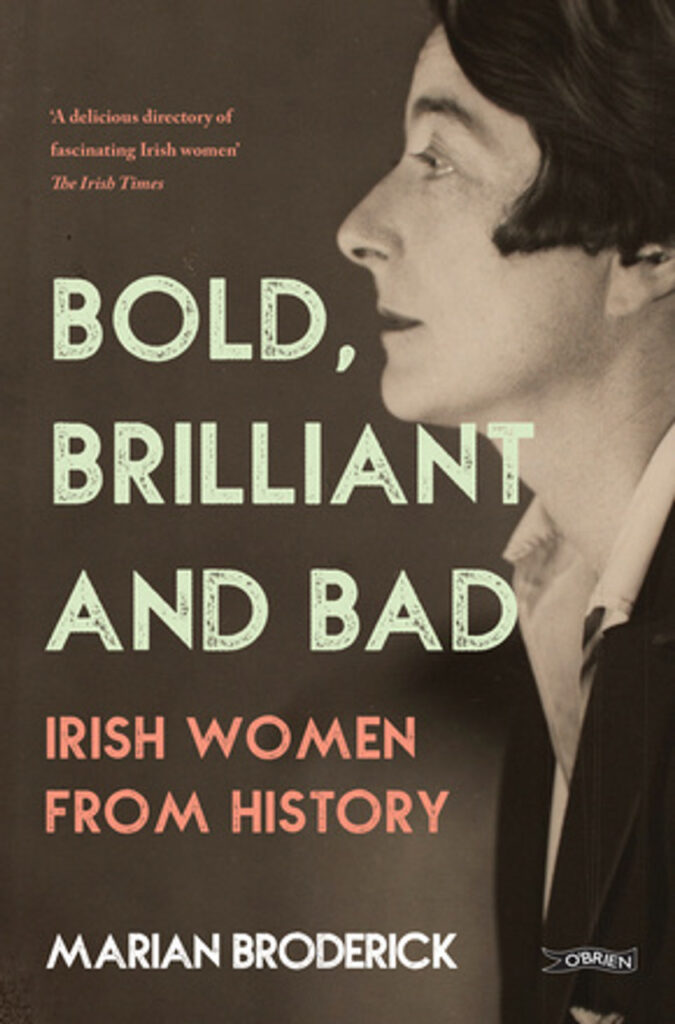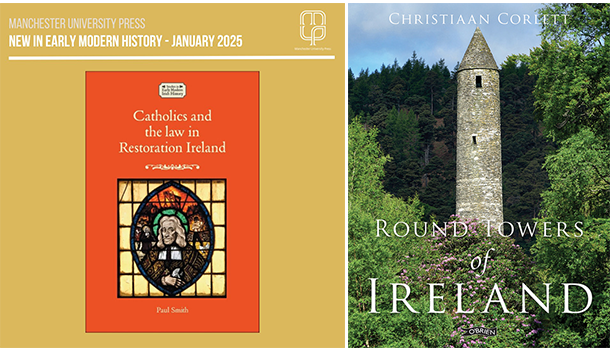By Daragh Fitzgerald
March’s International Women’s Day, marked on the date in 1917 when women workers in Petrograd protested for peace and bread and thus began the Russian Revolution, made Bold, brilliant, and bad: Irish women from history a prescient and inspiring read. Bringing forgotten women from Irish history to the fore, this book is replete with stories of women who overcame significant institutional and personal hurdles to thrive in the worlds of science, sport, politics and the arts, and some in the murky criminal underworld too. Who knew that the world’s first woman to design, build and fly an aircraft hailed from County Antrim? Or that maths whiz Kay McNulty, from the Donegal Gaeltacht, was a crucial part of the team that invented the first general-use digital computer? One of the many women documented is Annie Moore, the first person to enter America through the now-iconic Ellis Island immigration office. Annie was born into desperate poverty in Cork but received VIP treatment when she reached the US in a highly publicised ceremony in which she was gifted a $10 gold piece.
Annie was one of untold millions of Irish people, before and since, who took to the emigrant ship in search of a better life—the shortest way to Tara is via Holyhead, as Joyce tells us. Irish nuns and education in the Anglophone world: a transnational history is concerned with the previously neglected groups of religious women who left Ireland to establish convent schools and colleges for women around the world. The call of the convent was strong across the nineteenth century and into the twentieth century in Ireland, where grinding poverty, along with the dangers and drudgery of married life, encouraged many who may also have felt a sense of vocation to serve God or a desire for further education to take the habit. Another reason why one might join a religious order was to travel overseas as a missionary and see the world, as many Irish nuns did, founding educational projects from San Francisco to Melbourne, via Iowa, Newfoundland and Calcutta. These nuns certainly played a role in the pedagogy of ‘daughters of Empire’, but they retained strong bonds with Ireland and in many cases reproduced their Irish education across the Anglophone world.
Emigration across the British Empire, and particularly to the boundless plenty that apparently awaited in America, was good business in the nineteenth century, and Sir Adrian FitzGerald’s contribution to the Journal of the Kerry Archaeological and Historical Society demonstrates how the profit motive almost made Valentia Island a vital global node of transport. Sponsored by the likes of the Duke of Wellington and Prince Frederick, Duke of York, the American & Colonial Steam Navigation Company was founded in 1824 with the intention of running cargo and passengers between Halifax, Valentia Island and the West Indies. Valentia was chosen as the closest landfall in the United Kingdom to the North American continent, offering the shortest transatlantic sea crossing and thus the lowest consumption of fuel. However, internecine boardroom squabbling over the financing and purpose of the company, along with bitter personal feuds, ensured that this venture never got off the ground.
Despite the failings of the American & Colonial Steam Navigation Company, Irish migration to America of course only increased after the Famine, and by the end of the nineteenth century Irish-America was crucial to the republican movement, which sought international support for the cause, as well as material assistance, through the activities of Clan na Gael. Following the dispute between Clan na Gael and Dáil Éireann, and the Clan’s subsequent split, Joseph McGarrity replaced John Devoy as the most important republican figure in America, which he remained until his death in 1940. McGarrity is the focus of Seán Creagh’s study Republican solipsist: the life and times of Joseph McGarrity, 1874–1940. Creagh argues that as McGarrity spent most of the formative years of his political activity in America, away from the British and later Free State and Northern Ireland governments, he never had to deal with the same political repression that his comrades in Ireland faced, which shaped what Creagh refers to as his ‘political solipsism’, interested as he was almost solely with ending partition by revolutionary means and less so with broader social and political issues concerning those like Moss Twomey. This solipsism and the axiomatic acceptance of ‘England’s difficulty’ being an opportunity led McGarrity to Berlin in 1939 and into tentative negotiations with Hermann Göring that thankfully did not amount to much before McGarrity died in 1940, by which time the IRA were referring to the Nazis as ‘friends and liberators of the Irish people’.
The birth of the UK’s National Health Service in 1948 provided another motivation for many Irish people to spread their wings and cross the Irish Sea in search of gainful employment and adventure. Irish nurses in the NHS: an oral history tells the story of thousands of Irish women and men who worked as nurses across the UK in their own words, presenting a vivid impression of their work and social lives. Irish nurses were actively recruited by the NHS to train and work in British hospitals, with over 30,000 Irish-born nurses working across the NHS by the 1960s, accounting for 12% of the nursing staff. At the time, nurse training in Ireland was very limited and expensive, while better training, accommodation and pay conditions in Britain proved highly attractive (ringing any bells for readers with loved ones working as nurses Down Under?).
Out-migration from the Irish countryside in particular has been a recurrent theme in Irish life across the nineteenth, twentieth and now 21st centuries, as countless young people have left seeking a pathway to secure employment, particularly in times of economic downturn, while moving for education or adventure or to get away from repressive family and communal strictures have also encouraged this mass movement. Out-migration from the countryside is just one of the many themes tackled in Inside rural Ireland: power and change since independence. This collection charts the social and cultural development of rural Ireland from the early days of the state through to contemporary issues in a series of perceptive essays by leading historians and sociologists.
Paul Smith’s Catholics and the law in Restoration Ireland explores the various ways in which Irish Catholics engaged with the English Common Law system during the Restoration. While the seventeenth century was profoundly violent across Europe generally, the changes in Ireland were exceptional, as the population collapsed by a third between 1641 and 1652, and landownership changed dramatically to the benefit of new Protestant settlers and the detriment of Catholics. It is one of the ironies of history that the end of Cromwell’s ‘republican’ regime and the restoration of a British monarch heralded new possibilities for Catholics, hoping to regain their stolen land and prospects through the Common Law system from a friendly Stuart monarch. Protestant fears that the Stuarts were crypto-Catholics became reality when the Catholic James ascended to the throne and produced an heir, and Irish Catholic interest was ultimately smashed for generations at Aughrim.
Round towers of Ireland is a beautiful and informative book detailing the history and architecture of close to 50 round towers scattered across the island. Bell-towers were common to early medieval churches across Europe, but Irish round towers were distinctive in standing alone, separated from their associated church buildings. The text is full of striking photographs of the towers, discusses their meaning and purpose, and explains the historical, geographic, architectural and religious context of each.
Marian Broderick, Bold, brilliant, and bad: Irish women from history (O’Brien Press, €14.99 pb, 304pp, ISBN 9781788495691).
Deirdre Raftery, Irish nuns and education in the Anglophone world: a transnational history (Palgrave Macmillan, €117.69 hb, 250pp, ISBN 9783031462009).
Journal of the Kerry Archaeological and Historical Society, Vol. 24 (2024) (Kerry Archaeological and Historical Society, €20 pb, 120pp, ISBN 9781739837778).
Seán Creagh, Republican solipsist: the life and times of Joseph McGarrity, 1874–1940 (Peter Lang, €49.40 pb, 260pp, ISBN 9781803748931).
Louise Ryan, Gráinne McPolin and Neha Doshi, Irish nurses in the NHS: an oral history (Four Courts Press, €19.95 pb, 224pp, ISBN 9781801511636).
Tomás Finn and Tony Varley (eds), Inside rural Ireland: power and change since independence (UCD Press, €30 pb, 235pp, ISBN 9781739086367).
Paul Smith, Catholics and the law in Restoration Ireland (Manchester University Press, €119 hb, 236pp, ISBN 9781526176356).
Christiaan Corlett, Round towers of Ireland (O’Brien Press, €14.99 pb, 80pp, ISBN 978178495165).



